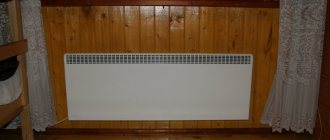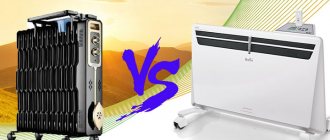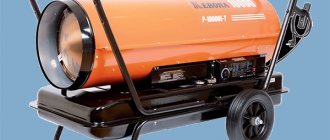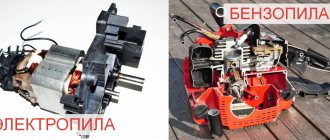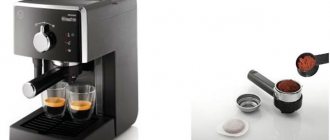You can heat the room in cold weather with any heater. However, the heating process will occur differently in each case. Therefore, many homeowners have to choose which heater is better, infrared or oil, and compare them with other types of convectors. It is possible to answer this question correctly only by studying the parameters, efficiency and other characteristics of each device.
Choosing which heater is better
Infrared
75%
Oil radiator
25%
Voted: 4
Operating principle of an infrared heater
The operating principle of infrared devices should be considered from the point of view of physical methods of transferring thermal energy in space. The main ones are:
- Convection. There is constant heat exchange in the air. Heated objects give off heat and heat the air, which, in turn, begins to rise upward. Heavier cold air currents take its place, and the whole process is repeated in the presence of a heat source.
- Radiant energy. All surfaces with a temperature above 60 degrees begin to intensely emit electromagnetic waves that have thermal energy. To obtain this effect, the waves must be in the range from 0.75 to 100 microns. This principle is used in the heating elements of IR heaters.
The heater itself is placed in a metal case coated with protective paint against corrosion. The internal part is filled with an aluminum reflector that acts as a heat emitter. It receives primary heat from heating elements.
The operating principle of an infrared heater is implemented in the following sequence:
- Current flows to the element and heats it.
- The element transfers its heat to the reflector - the heat-emitting plate.
- The heat reflected from the plate is emitted into space in the form of directed infrared rays.
- The rays hit surfaces within reach and heat them.
- Next, the principle of convection discussed above comes into play. Heat is transferred from surfaces and heats the surrounding air, providing uniform heating in a given area.
Comparison of an infrared heater with an oil heater
Everything can be learned by comparison, including choosing the most suitable heater. First of all, you need to compare their parameters, capabilities and functionality in relation to specific operating conditions.
What heats better is an oil radiator or an infrared one?
Heaters with coolant oil heat quite well, but at the very beginning after switching on they warm up very slowly. The heating process lasts approximately 30 minutes, and during this time the room will be either cold or cool. Many devices are equipped with fans that accelerate air movement, reducing heating time.
The length of infrared waves is identical to the sun's rays, so a person perceives heat in this way. The rays spread unhindered and are not afraid of wind or drafts. Effective heat exchange allows you to feel the warmth in the shortest possible time. It should be remembered that not the entire room is heated, but only those areas where the rays are directed.
The maximum room temperature is reached after operating the IR heater for several hours. After turning off the device, the surfaces still continue to give off heat, but not for long. In this case, oil radiators cool down much more slowly.
Which heater is more economical?
If you compare the efficiency of both devices and decide which is better, then, of course, IR devices win. Their electricity consumption is approximately 10-30% less than that of oil heaters with the same power. Similar savings can be achieved by reflective plates installed behind the heating elements.
However, the associated operating costs for oil radiators are significantly lower. They do not require spare parts, maintenance or expensive repairs. IR devices require periodic replacement of lamps or bulbs that have expired.
Therefore, each room should be carefully considered and assessed based on the feasibility of installing this particular device in it. Optimizing the use of heaters will go a long way toward balancing overhead costs.
Size comparison
Infrared and oil heaters have approximately the same dimensions. There are many different designs, models and options, one way or another related to the principles of operation of the devices. A lot depends on the power, which directly affects the dimensions of the device.
- Oil heaters are placed on the floor or wall. There are no ceiling models, since it is irrational to use such devices at the top. There will simply be nowhere for the warm air to rise.
- Infrared devices can be installed anywhere. Depending on the size and weight, they have legs, vertical stands, ceiling, wall and corner mounts.
Oil heater - compared to IR
An oil heater, or, as it is also called, an oil radiator, consists of, in fact, an oil battery (a battery that contains oil) - usually two heating elements (or heating elements) are built into it, a thermostat, which, depending on the air temperature in indoors turns the heating element on or off. Also, taking into account the oil content in the battery, such heaters are equipped with tip-over protection - a special device that will turn off the heating if the device is not in a vertical position. Some models are also equipped with a small fan. But, given the design features of the oil radiator, such a fan is not particularly effective. Depending on the model, the oil heater may contain other safety or control elements.
Infrared heating circuit
An oil heater gives off heat in two ways:
- 80% of the energy is released through convection - the natural circulation of heated air. This is the main method of heat transfer for the oil cooler. (In general, this heating method is called indirect);
- 20% is transmitted via infrared or thermal radiation, which is considered direct heating.
The air heated between the plates of the oil heater rises, forming air circulation in the room and thus gradually warming up all the air. Infrared radiation does not heat the air, but objects nearby.
pros
Safety can be considered a big advantage of an oil heater. Due to the low surface temperature of the heater itself, as well as due to the group of protections:
- From capsizing;
- Overheating;
- Etc.
The second advantage of an oil heater is its relative efficiency.
The third plus is durability. Many models last 5-10 or even more years.
The fourth plus is that at low temperatures the oil heater does not dry out the air.
The fifth plus is the combined heating method. Heat is transferred both by convection (indirect heating) and infrared rays (thermal radiation), which is direct heating.
Minuses
This type of heating device, however, is not the most economical. For example, a split system will be more economical. Also, a ceramic stove-heater is a little more economical.
Tips for choosing a heater for your home
In order to avoid unnecessary material waste when choosing an oil or infrared heater, you should adhere to certain rules. First of all, you need to consider the following factors:
- Place of installation of the device. It is recommended to determine in advance, since the type of heater and the efficiency of further heating directly depend on this. It should be taken into account that oil radiators are quite bulky, and falling is contraindicated for IR devices. In addition, they require certain installation methods. The most optimal models are wall-mounted. They cannot be touched by negligence, and they do not take up useful space in the room.
- Heater power for home. It is recommended to select this parameter according to a simple scheme: per 10 m2 of area, 1 kW of energy will be required for an oil radiator and 0.5 kW for an infrared device. Otherwise, the heater will not give the desired effect.
- Heater control. Mechanical and electronic systems are commonly used. The first option is cheaper, but it wears out quickly, has limited functionality, and has a high error in settings. Electronics, despite the high price, are much more efficient. Its precise operation makes using the heater more convenient and comfortable.
- Heating temperature. Oil-based appliances can become very hot during operation. Therefore, if you have small children, you should buy models where the surface of the radiator is protected by a frame that prevents direct contact with the hot surface. Among IR devices, there are micathermic devices that emit heat, but themselves remain cold.
Infrared heaters compared to oil heaters
It is worth noting that there are gas infrared heaters that have their own significant advantages. For example, such heaters are very mobile. They can be used, for example, on winter fishing or on a picnic. Also, such thermal elements will be indispensable where there is no electricity, perhaps in the country. There are models with high power that can be suitable for heating large rooms. But a serious drawback of such heating systems is the combustion products that remain in the room if there is no hood, and most models of such heaters do not have an hood.
Comparison of two types of devices
But, to be fair, we will compare electric oil heaters with electric IR heaters.
Design
Electric infrared heaters are very diverse in purpose and design. Basically their design consists of:
- housings,
- electric cable,
- fastening elements - legs, wall fasteners.
The heating element of such systems is often sealed in a glass bulb to prevent the coil from coming into contact with oxygen.
The heater design also includes:
- control group, which, for example, includes a thermostat,
- Overheating and tip-over protection.
A huge advantage of an infrared heater over an oil heater is that the former transfers almost 100% of the heat using thermal radiation.
One type of infrared is quartz heaters
Infrared waves are long-wavelength, invisible radiation that is felt by humans as heat. On Earth, the main source of infrared radiation is the Sun.
Also, there are so-called quartz heaters - these are the same infrared heaters. They are based on a slab with quartz sand.
By the way, did you know that the Sun is the largest infrared heater in the Solar System? When you're on the beach in the summer, we're sure you can't go wrong whether to choose an oil or "infrared heater" for tanning. J.
Infrared heaters are mainly divided into three groups:
- industrial - heaters for workshops, large hangars;
- commercial and industrial - for shops, exhibition pavilions;
- the most common are household ones - for apartments, garages, houses, offices.
Operation and care of heaters
Any device will last much longer if you follow simple rules during operation:
- You cannot place things to dry on a radiator that is on. This can only be done after first disconnecting the device.
- When the infrared heater is turned on, it should not be located near flammable objects. The distance from any objects should not be less than 50 cm.
- Avoid touching the electrical cord to the hot surface of the heater.
- Keep the device clean and regularly wipe away dust. In this case, the device must be turned off in advance and allowed to cool.
- Floor-standing models can only be used in a vertical position.
